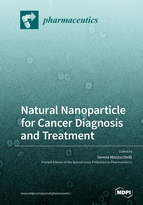Natural Nanoparticle for Cancer Diagnosis and Treatment
A special issue of Pharmaceutics (ISSN 1999-4923). This special issue belongs to the section "Nanomedicine and Nanotechnology".
Deadline for manuscript submissions: closed (28 February 2022) | Viewed by 35425
Special Issue Editor
Interests: nano-oncology; nano-drug delivery; protein nanocages; breast cancer; nano-tracers
Special Issues, Collections and Topics in MDPI journals
Special Issue Information
Dear Colleagues,
In the last twenty years, nanoparticles have been extensively studied as carrier for cancer imaging and drug delivery, since they are useful to improve bioavailability, tissue penetration, and circulation time of their cargo molecules. However, nanoparticle toxicity, immunogenicity, and sequestration by macrophages are issues that strongly limit their clinical translation. In this scenario, natural nanoparticles, such as exosomes and protein or DNA nanocages represent a charming alternative to synthetic metal or polymeric nanoparticles, thanks to their safety, biocompatibility, and biodegradability due to their biological nature. Their production and manipulation take place in mild conditions, preserving drug or probe functionality. Moreover, they generally display high stability in the physiological environment, allowing researchers to avoid common problems related to nanoparticle aggregation. They could also be modified by inserting surface functionalities to affect stability, surface charge, and ligand display, in order to maximize their bioavailability, tumor targeting, and tissue penetration. Moreover, natural nanoparticles are generally arranged to form a shell that displays three regions of interfaces, allowing researchers to realize multifunctional nanoparticles by combining nano-probes for imaging with drug delivery devices. These features are strongly appealing in order to face cancer, where the development of tumor-targeted specific devices could be useful to improve patient compliance.
This Special Issue serves to depict the current landscape of natural nanoparticles developed to improve cancer management and we invite articles able to better highlight any feature about natural nanoparticles exploited for cancer.
Dr. Mazzucchelli Serena
Guest Editor
Manuscript Submission Information
Manuscripts should be submitted online at www.mdpi.com by registering and logging in to this website. Once you are registered, click here to go to the submission form. Manuscripts can be submitted until the deadline. All submissions that pass pre-check are peer-reviewed. Accepted papers will be published continuously in the journal (as soon as accepted) and will be listed together on the special issue website. Research articles, review articles as well as short communications are invited. For planned papers, a title and short abstract (about 100 words) can be sent to the Editorial Office for announcement on this website.
Submitted manuscripts should not have been published previously, nor be under consideration for publication elsewhere (except conference proceedings papers). All manuscripts are thoroughly refereed through a single-blind peer-review process. A guide for authors and other relevant information for submission of manuscripts is available on the Instructions for Authors page. Pharmaceutics is an international peer-reviewed open access monthly journal published by MDPI.
Please visit the Instructions for Authors page before submitting a manuscript. The Article Processing Charge (APC) for publication in this open access journal is 2900 CHF (Swiss Francs). Submitted papers should be well formatted and use good English. Authors may use MDPI's English editing service prior to publication or during author revisions.
Keywords
- natural nanoparticles
- drug delivery
- tumor-targeting probes







